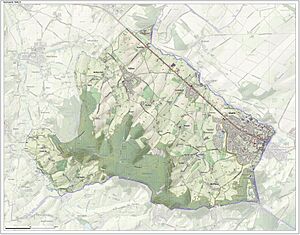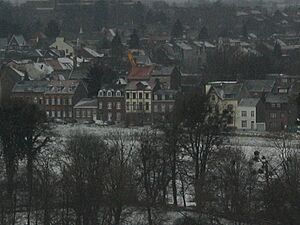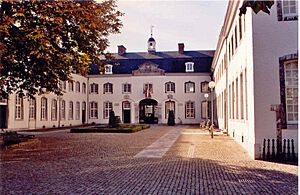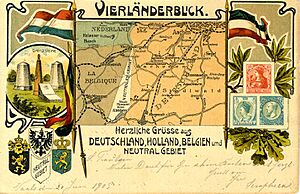Vaals facts for kids
Quick facts for kids
Vaals
Vols
|
|||
|---|---|---|---|
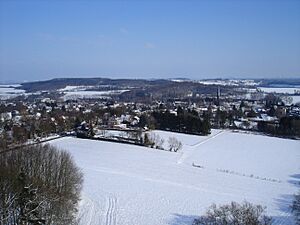
View of Vaals
|
|||
|
|||
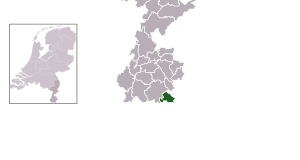
Location in Limburg
|
|||
| Country | Netherlands | ||
| Province | Limburg | ||
| Government | |||
| • Body | Municipal council | ||
| Area | |||
| • Total | 23.87 km2 (9.22 sq mi) | ||
| • Land | 23.86 km2 (9.21 sq mi) | ||
| • Water | 0.01 km2 (0.004 sq mi) | ||
| Elevation | 200 m (700 ft) | ||
| Highest elevation | 322.7 m (1,058.7 ft) | ||
| Population
(May 2014)
|
|||
| • Total | 9,691 | ||
| • Density | 406/km2 (1,050/sq mi) | ||
| Demonym(s) | Vaalzer | ||
| Time zone | UTC+1 (CET) | ||
| • Summer (DST) | UTC+2 (CEST) | ||
| Postcode |
6290–6295
|
||
| Area code | 043 | ||
Vaals is a town located in the very southeastern part of the Dutch province of Limburg. This province is in the southeast of the Netherlands.
The municipality of Vaals covers an area of about 23.92 square kilometers. It sits in the western hills of the Ardennes and Eifel mountain ranges. Vaals is about 23 kilometers east of Maastricht and only 5 kilometers west of the German city of Aachen.
Vaals is unique because it borders both Belgium and Germany directly. Three national borders meet at a spot called the Drielandenpunt (Three-Country Point). This spot is also very close to the highest point in the Netherlands, which is also called the Vaalserberg. The Vaalserberg was once known as "Hubertusberg," named after an important person from the eighth century, St. Hubertus.
Contents
Discovering Vaals' Past
The name Vaals comes from Latin, which is quite rare for a Dutch place. The southern part of the Dutch province of Limburg, where Vaals is located, was once part of the powerful Roman Empire. The main Roman city in this area was what is now Cologne in Germany.
Vaals was first mentioned in official papers in the year 1041. Back then, it was called Vals or Vallis, which means "valley." In that year, Holy Roman Emperor Henry III gave land to a church called the Abbey of St. Adalbert. To make sure everyone knew which land it was, it was specifically described as being "in the valley"—in Vallis.
Vaals' location in Europe meant it became a border area between different groups. In the 1500s, Catholic Spain tried to stop a Protestant uprising in its Dutch lands. During this war, a group supporting Protestant William of Orange passed through Vaals in 1568. They took items from the Catholic St. Paul's Church.
Vaals as a Manufacturing Hub
In 1661, Vaals became part of the Republic of the United Netherlands. This change attracted business people who helped the town grow into a busy manufacturing center. One important family was the Von Clermonts. They moved to Vaals from Aachen (which was then part of Prussia) in 1761. They started a very successful linen factory. Their products were popular in places like Prussia, Austria, Poland, and even Russia. It is said that Tsar Peter the Great visited the Von Clermonts in 1717. Later, in 1803, Napoleon Bonaparte, the Emperor of France, and his wife Josephine de Beauharnais visited Vaals. They stayed in the family's beautiful Bloemendal Castle.
Changing Borders and New Beginnings
After a big meeting called the Conference of Vienna in 1815, the city of Aachen was given to Prussia. Vaals, however, became part of the Kingdom of the Netherlands. Then, in 1830, Belgium declared its independence from the Netherlands, and Vaals became part of Belgium. But in 1839, a new agreement called the Treaty of London moved Vaals back to the Netherlands.
This treaty also created a small, special area called Neutral Territory of Moresnet. Its new borders met with Belgium, the Netherlands, and Prussia right outside Vaals. Moresnet had its own flag (Black-White-Blue) but no official leader. It was created because nearby European countries wanted to share the valuable tin found there. A road in Vaals, the Viergrenzenweg ("Four-Borders-Road"), still reminds us of this time. Moresnet existed from 1839 to 1919, when it became part of Belgium.
During the 1800s, factories grew in other countries, and new trade rules made it harder for Vaals to sell its goods. Because of this, manufacturing in Vaals declined after 1840. The town then slowly became a popular resort, especially for German visitors. Vaals was even called 'Vaalser Paradies' (Vaals Paradise) and had several casinos. To help people travel between countries, a tram line was built. It connected Aachen to Vaals by 1922 and extended to Maastricht by 1924.
Vaals in Modern Times
Even though the Netherlands said it would stay neutral before World War II, German forces took over Vaals on May 10, 1940. This was the first day of fighting in western Europe. The German occupation lasted over four years. Vaals was freed by Allied forces in September 1944.
After the war, it took a while for Vaals to recover. This led to a lot of smuggling. People who smuggled goods across the border at night were known as the 'Owls of Vaals'. They made money by trading things like coffee, chocolate, and tobacco.
Today, Vaals is still a popular place for tourists, especially from Germany, Belgium, and the Netherlands. It's also a shopping center, particularly for Germans. You could say Vaals acts like a Dutch suburb of the German city of Aachen. About a quarter of the people living in Vaals are German. Vaals is also well connected to Aachen's public transport system.
The German dialect spoken in Vaals is a type of Middle German. It is quite different from standard Dutch. This dialect is part of a group called the Ripuarian language family, which includes other dialects spoken in western Germany.
Vaals' Population
The municipality of Vaals includes four villages and nine smaller communities called townships. Because Vaals is so close to Germany, about a quarter of its current population is of German background.
Villages in Vaals
Here are the populations of the main villages as of January 1, 2005:
|
Hamlets in Vaals
Besides the official villages, the Vaals municipality also has several smaller communities:
- Camerig
- Cottessen
- Harles
- Mamelis
- Melleschet
- Raren
- Rott
- Wolfhaag
Vaals' Economy
Tourism is the main way Vaals earns money. The nearby coal mines and textile factories, which used to be important, mostly closed down starting in the 1960s. Today, most people who live in Vaals travel to work in bigger nearby cities. These include Heerlen, Kerkrade, and Maastricht in the Netherlands, as well as Aachen and its surrounding areas in Germany. About one-sixth of the people in Vaals are considered to be living in poverty, according to a national report in the Netherlands.
Notable People from Vaals
- John Bröcheler (born 1945 in Vaals) is an opera singer known for his deep voice.
- Eddy Verheijen (born 1946 in Vaals) is a retired speed skater who competed in the 1972 Winter Olympics.
- Ronald Waterreus (born 1970 in Lemiers) is a former Dutch football goalkeeper who played in 423 club games.
Images for kids
See also
 In Spanish: Vaals para niños
In Spanish: Vaals para niños




